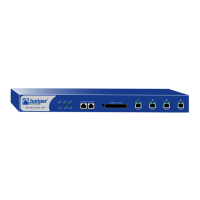$SSHQGL[%&RQILJXUDWLRQIRU&RPPRQ&ULWHULD($/
% 1HW6FUHHQ
3523(567(36726(&85($1(76&5((1'(9,&()25
&
20021&5,7(5,$($/&203/,$1&(
To configure a NetScreen device to operate securely, and in conformance with the
requirements outlined in NetScreen’s Security Target for Common Criteria EAL2, the
following actions must be taken:
• You must configure a Syslog server as a backup for security audit information,
and for long-term audit log information storage. This will help prevent a loss in
security audit information. See Chapter 2, “Monitoring NetScreen Devices,” in
Volume 3 of the NetScreen Concepts & Examples manual for more information
on how to set up and configure a Syslog server to work with NetScreen devices.
The specific commands required to set up a Syslog server are listed below:
set syslog config ip_address security_facility
local_facility
set syslog enable
set syslog traffic
set log module system level level destination syslog
• There are cases where more auditable events can occur than the NetScreen
device is able to write to a syslog server. To be compliant with Common Criteria
requirements, the NetScreen device must stop further auditable events from
occurring until the audit trail is able to handle more traffic. An authorized
administrator must enable the following command:
set log audit-loss-mitigation
• The NetScreen-5XP and NetScreen-5XT have a default policy that allows traffic
to traverse the device from the interface in the Trust zone to the interface in the
Untrust zone. You must delete this default policy to avoid inadvertently
allowing information to traverse the device. See the policy commands in the
NetScreen CLI Reference Guide for more information on how to set and unset
policies.
Note: The set syslog config command requires that you define the security
facility and local facility. See the syslog command in the NetScreen CLI
Reference Guide for a complete list of options for security_facility and
local_facility.
Note: You must enter the set log command once for each message level. The
options for level are listed below:
emergency
alert
critical
error
warning
notification
information

